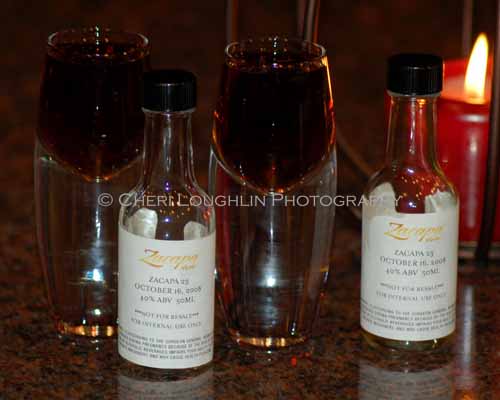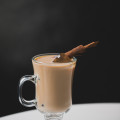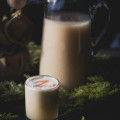A friend of mine tasted Zacapa 23 and promptly told me it would definitely be my next rum muse. When a representative contacted me about reviewing the Zacapa 23, I was tickled beyond words. It would be arriving on my doorstep and I would soon be savoring the flavor of this Guatemalan rum aged in the “house in the clouds.” 
Zacapa 23 is amazing rum with an equally remarkable heritage. This fact became exceedingly clear when I opened the box with the sample. The Zacapa 23 arrived with seventeen pages of material as an “Introduction to a Masterpiece.” As Master Distiller Lorena Vasquez aptly states, “Zacapa Rum is born from the rich culture and heritage of Guatemala. I’m excited to bring this delicate and special spirit to people across the United States.”
Zacapa Rum is exceptional within the rum category. It is produced using only the first pressing of sugar cane juice, referred to as “virgin honey” in Guatemalan dialect. Zacapa uses a Sistema Solera aging process, with the rum resting in barrels that previously aged Bourbons, Sherries and Pedro Ximenez wines. Sistema Solera is a time-honored, vibrant aging process in which spirits of different ages and characteristics are blended and then afterward stored in selected barrels to continue the maturing process.
The “house in the clouds” is one of the better known aspects of the aging process. Located 8,000 feet above sea level with an average temperature of 62 degrees Fahrenheit allows Zacapa to develop its characteristic color, body, flavor and aroma. Several atmospheric conditions contribute to this aging process:
Aging is never subjected to wide variations in temperature.
The barrels never dry out on the exterior.
Cooler temperature and altitude with thinner air lend pressure to the atmosphere that intensifies aging at a slower pace.
Zacapa Rum’s distinctiveness is inseparable from the landscape and culture of Guatemala. Zacapa’s name is from an actual Guatemalan city who gave the rum its name in celebration for the 100th anniversary of its founding in 1876. Suchitepéquez is the place in which the sugar cane plantations grow for the foundation of Zacapa. The people of Jocotan provide the handmade petaté band that surround each bottle of Zacapa. Mixco provides the main bottling and distribution facility for Zacapa. In this way, Zacapa Rum is integrated with the communities throughout the country. This unity is symbolized by the palm band (petaté) around the bottle.
These hand-made, woven petaté bands are made from dried palm leaves. They are carefully wrapped around each bottle of Zacapa. The petaté band dates back to 1400 BC during the Mayan Period. First woven as floor mats, weavers believed sitting on petaté changed ones view of the world to force one to look at life with humility. Petaté also symbolizes the unity of everything. Since Zacapa is so closely tied to the land and culture it is appropriate that the woven band is placed on the bottles. However, it is not just a decorative band.
The bands are produced by the women of the Chorti community in Jocotan. In 2003, a productive chain was created that allowed Jocotan to sell its artisanal production. A supply mechanism began. At that time only 40 to 50 artisans worked to produce 2,000 bands a month. Now 350 artisans work and average a production of 20,000 petaté bands per month. This economic growth has raised the strength of women in the community. The sustainability of this project is supported by the producers of Zacapa and has allowed these woman artisans to improve their quality of life. Other industries have followed suit and employed these workers to create other types of creations from petaté.
Ah, but as extraordinary as Zacapa is on the surface, I know you are looking forward to what is inside the bottle. Zacapa has been described as “about as indulgent as rum gets”, “smooth and luscious” and “a seriously decadent rum.” Flavors include nutmeg, toasted hazelnut and a hint of caramel with chocolate. Zacapa finishes smooth with a long aromatic persistence and is best enjoyed neat or on the rocks. Zacapa has won numerous awards that place it in the category of super and ultra-premium rums. All of which may be read about on the official website.
My findings on Zacapa 23: It is thicker than other rums I have had the opportunity to sample recently, syrupy and sweet with dark molasses tones. I could not however detect the caramel. There is almost the flavor of licorice on the back end of the tasting. It is not quite black licorice, because it is not that strong. It is not quite red licorice as it is not fruity. The feel on the back of the tongue is indulgent and full. Zacapa 23 is smooth with a slight welcome pungent bite on the back end.
Although the recommendation is for sipping neat or on the rocks, I stretched my small sample into a mini daiquiri. I realize enthusiasts are cringing at the moment, but one never knows what may happen until one ventures into the unknown. With the ratio of 1 part rum, 1/2 part fresh lime, 1/4 part bar syrup, I mixed up a daiquiri. The lime mixes with the molasses flavor giving an almost orange zest flavor combination to the drink. The strong character of the Zacapa 23 is lost in a way. The cocktail has nice color and taste, but makes perfectly clear why the recommendation for Zacapa 23 is to savor neat or on the rocks. Which in the future, sipping Zacapa 23 neat is exactly how I will choose to consume this Guatemalan gem.
You might also like: Zacapa Rum 23: Exceptional Flavor & Fun Fact of the Day with Official Tasting notes from the brand.
Cheri Loughlin is a leading cocktail and photography resource for beverage companies, event planners, businesses and individuals. High resolution cocktail and beverage stock photography images are available in downloadable digital format in the newly redesigned Stock Photography Gallery at www.cheriloughlin.com.
Twitter, Facebook, StumbleUpon – str8upcocktails @ gmail.com – ©2012 Cheri Loughlin-The Intoxicologist, All Rights Reserved. All opinions, reviews and spirits’ coverage are the personal opinion and decision of Cheri Loughlin.


